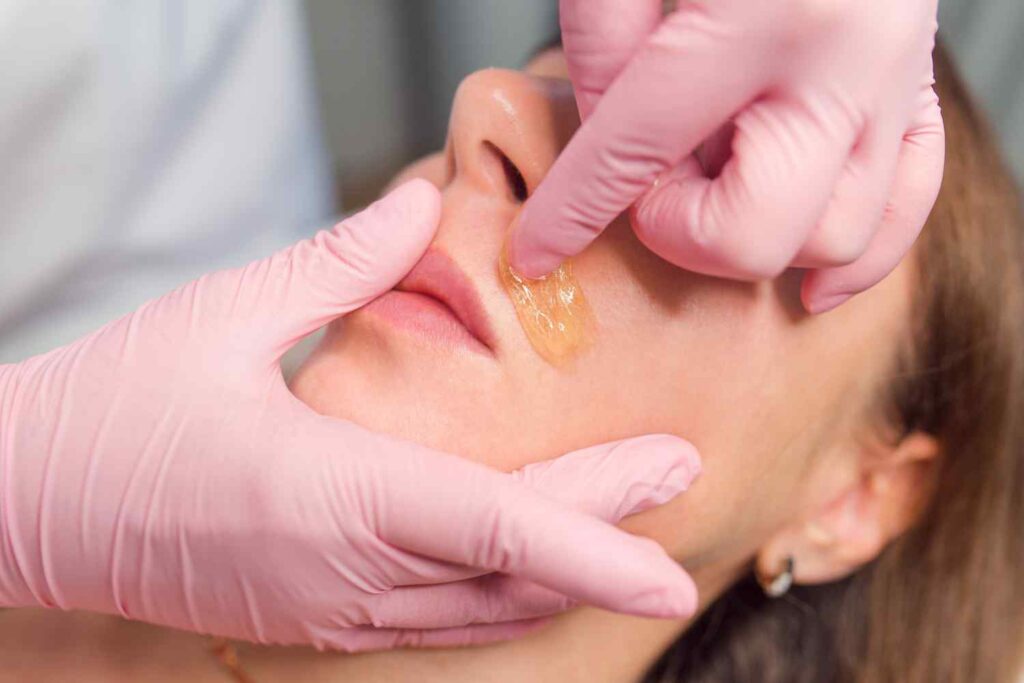
- December 20, 2023
- Comments: 0
- Posted by: admin
 In an era where environmental consciousness is paramount, the beauty industry is evolving to embrace eco-friendly practices. Waxing and sugaring, two popular hair removal techniques, are paving the way for sustainable beauty experiences. In this blog, we will explore the journey towards eco-friendly beauty in the realms of waxing and sugaring, where conscious choices contribute to a greener and more sustainable future.
In an era where environmental consciousness is paramount, the beauty industry is evolving to embrace eco-friendly practices. Waxing and sugaring, two popular hair removal techniques, are paving the way for sustainable beauty experiences. In this blog, we will explore the journey towards eco-friendly beauty in the realms of waxing and sugaring, where conscious choices contribute to a greener and more sustainable future.
1. Natural Ingredients and Biodegradability
Waxing with Earth-Friendly Formulas
- Firstly, many waxing salons are adopting eco-friendly waxes formulated with natural ingredients, such as beeswax or soy-based waxes.
- These natural waxes are biodegradable, reducing the environmental impact associated with traditional waxes that may contain synthetic materials.
Sugaring’s Sweet Sustainability
- Sugaring, a technique that uses a mixture of sugar, lemon juice, and water, is inherently eco-friendly due to its natural composition.
- The ingredients in sugaring are biodegradable, making it a sustainable alternative for individuals seeking greener beauty practices.
2. Minimal Environmental Footprint
Reducing Waste
- Secondly, eco-friendly salons are adopting practices that minimize waste, such as using reusable spatulas for applying wax or sugaring paste.
- The reduction of single-use items contributes to a more sustainable beauty routine with a minimal environmental footprint.
Biodegradable Strips and Materials
- Additionally, the use of biodegradable waxing strips and materials further enhances the eco-friendly approach.
- Salons committed to sustainability prioritize materials that break down naturally, reducing the impact on landfills.
3. Energy-Efficient Practices
Temperature Control for Waxing
- Eco-conscious salons are adopting energy-efficient waxing practices by optimizing temperature control during wax application.
- Using energy-efficient wax warmers and ensuring precise temperature settings contribute to a greener approach to hair removal.
Sugaring at Room Temperature
- Moreover, sugaring is often performed at room temperature, eliminating the need for energy-consuming heating elements.
- This practice aligns with energy-efficient approaches, reducing the overall environmental impact associated with beauty treatments.
4. Sustainable Packaging
Eco-Friendly Wax Packaging
- Moreover, salons committed to sustainable practices opt for eco-friendly wax packaging, such as containers made from recycled materials.
- Choosing packaging with minimal environmental impact extends the commitment to sustainability beyond the treatment itself.
Minimalist Sugaring Jars
- Sugaring paste is often packaged in minimalist jars, reducing excess packaging materials.
- Eco-friendly salons prioritize sustainable packaging choices that align with their commitment to environmentally conscious practices.
5. Ethical Sourcing of Ingredients
Sourcing Natural and Sustainable Ingredients
- Furthermore, eco-friendly salons are mindful of the sourcing of ingredients, opting for natural and sustainably harvested materials.
- The ethical sourcing of ingredients ensures that the beauty treatments are not contributing to deforestation or harm to ecosystems.
Supporting Ethical and Eco-Conscious Brands
- Salons dedicated to eco-friendly beauty practices partner with brands that share their commitment to sustainability.
- Supporting ethical and eco-conscious brands fosters a community of like-minded businesses working towards a greener beauty industry.
6. Educating Clients on Sustainable Beauty
Empowering Clients with Knowledge
- Eco-friendly salons play a crucial role in educating clients about the benefits of sustainable beauty practices.
- By empowering clients with knowledge, salons contribute to a broader movement towards environmentally conscious consumer choices.
Encouraging Responsible Aftercare
- Additionally, salons encourage clients to adopt responsible aftercare practices, such as using eco-friendly exfoliating products or moisturizers.
- Responsible aftercare extends the sustainability journey beyond the salon visit, promoting long-term eco-friendly habits.
Conclusion
In conclusion, as the beauty industry transforms sustainability, realms of waxing and sugaring, emerge as pioneers in eco-friendly beauty practices. From natural ingredients to minimal environmental footprints and ethical sourcing, these techniques embody a commitment to a greener future. At Blink Lash Club, our dedication to eco-friendly beauty extends to our waxing and sugaring services, providing you with a sustainable and conscious approach to hair removal. So, book your appointment today and join us in sculpting beauty while preserving the beauty of our planet.
Discover a wealth of informative and useful content at Blinklashclub Blogs, where knowledge meets inspiration.
